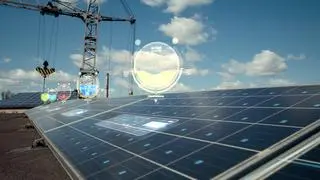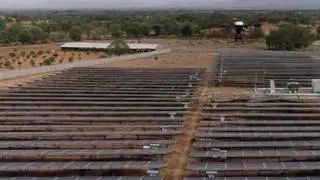In September, India’s installed solar power capacity crossed the 90GW mark to reach 90,762 MW. Given the current rate of monthly capacity additions, which have been upwards of 2,000 MW, there is little doubt that installed capacity will exceed 100 GW in 2024-25.
Although the 100 GW target was initially set for 2022, achieving this milestone, even with a delay, is still commendable.
Bold course
It has been an exciting journey for the Indian solar sector, which was born in January 2010, when the Government of India launched the Jawaharlal Nehru National Solar Mission (JNNSM). For the first ever solar tender (JNNSM Phase-I, Batch I), put out by NTPC Vidyut Vyapar Nigam, the Central Electricity Regulatory Commission notified a benchmark tariff of ₹17.91 per kWhr without the ‘accelerated depreciation’ benefit, and ₹14.95 if the bidder claimed the benefit. When the bids were submitted for 140 MW, the best bid was ₹12.16 a kWhr.
In the next tender (Batch II), a French company called Solaire Direct won 5 MW, quoting a tariff of ₹7.49. Newspapers reported it as “sub 8 surprise” because any tariff below ₹8 was considered unthinkable at that time. Solaire Direct faced criticism for its “irresponsible” bid, which according to the industry experts would only raise unrealistic tariff expectations.
Such trenchant criticism would continue in the coming years whenever a bidder won a project quoting a low price. For example, in June 2015, a Canadian company called SkyPower emerged winner in a tender, quoting ₹5.05 a kWhr, it evoked the industry’s ire. However, Pashupathy Gopalan, who headed the Asia Pacific operations of the US company, SunEdison, made a prediction that by the end of the year (2015), solar tariffs would slide below the ₹5-mark. Gopalan himself made the prediction come true when, in November 2014, SunEdison won 500 MW in Andhra Pradesh, quoting ₹4.63. This writer remembers the vitriolic comments made by many in the solar industry against SunEdison for “messing up the market.” Those were the days when the solar industry used to speak of attaining “grid parity” — roughly, the price of conventional power.
The slide show continued, reaching ₹2.36 a kWhr in July 2020 and incredible — though flash in the pan — tariff of ₹1.99 in December that year.
Today, the tariffs have risen from such depths. Standalone solar tariffs are around ₹2.60-2.70 levels now. For example, Zelestra signed a PPA with NTPC in August to supply solar power at ₹2.60.
The renewable energy scene has shifted a lot in recent years, with successive tenders asking for round-the-clock or ‘firm dispatchable renewable energy (FDRE). The tariffs for these are at a premium of ₹1.50-2, to the basic renewable energy price, which is expected to come down a little when pumped hydro storage facilities become operational. The big message from today’s ruling tariffs is that non-intermittent renewable energy is indisputably cheaper than power from new coal projects, with a downward bias.
How did we get here?
If solar tariffs have come down so drastically in just about twelve years, it is because of the vertiginous fall in module prices. When JNNSM was introduced, module prices were a dollar a watt-peak. Today, it is around 10 cents. Not in the wildest of imagination did anyone think of such a fall.
For this, one has only China to thank for. “China has been instrumental in bringing down costs worldwide for solar PV, with multiple benefits for clean energy transitions,” says the International Energy Agency. According to consultancy firm Wood Mackenzie, China has invested $130 billion into solar manufacturing to now have a capacity of 1,405 GW, from 6.4 GW in 2010. As the scale-effect kicked-in, module prices fell.
Alongside, technology also rose to help. Back in 2010, the best solar modules could convert 17 per cent of the sun’s energy falling on them into electricity. Technology kept getting better — from polysilicon to monosilicon to bifacials to mono-PERC to n-type TopCon modules, which now boasts efficiencies of 22-26 per cent.
That is the solar of today.
Tech-fuelled ambitions
But this is only the chapter one. There’s a lot more to follow in the solar story. Even if one assumes that the module prices have (finally) hit the bottom, technology has not. A ‘tandem cell’ developed by the Chinese company, LONGi Green has been certified by the US National Renewable Energy Laboratory as having a conversion efficiency of 33.9 per cent — a global record.
Start-ups are also ringing in success in many areas of technology. A Chennai-based start-up called Datasee is using drones to improve construction efficiencies. Bengaluru-based Renkube has devised a system for throwing more sunlight onto the modules using prisms — eliminating the need for the messy trackers. Agro-voltaics — where you grow crops under the modules or between rows — is duly occupying its niches. ‘Floating solar’, a phenomenon that is gaining ground, is yet to be fully milked, as is the use of solar powered agricultural pumps.
And, the demand is growing. With companies committing themselves to decarbonisation, purchase of renewable energy is gaining ground. For example, Google India recently announced direct purchase of renewable energy from Adani Green and CleanMax. India installed a record 15 GW in 2023-24; in the first half of 2024-25, it did 14.9 GW, according to the consultancy, Mercom. Indeed, the sun is shining.








Comments
Comments have to be in English, and in full sentences. They cannot be abusive or personal. Please abide by our community guidelines for posting your comments.
We have migrated to a new commenting platform. If you are already a registered user of TheHindu Businessline and logged in, you may continue to engage with our articles. If you do not have an account please register and login to post comments. Users can access their older comments by logging into their accounts on Vuukle.